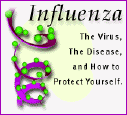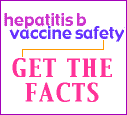



Introduction / Task / Process /Resources / Evaluation / Conclusion




Introduction / Task / Process /Resources / Evaluation / Conclusion
In our world
today, many diseases and disorders exist that affect us and the ones we
love. They are caused by many things, including viruses, bacteria and genes.
It is your job as a disease specialist to select a particular disease and
disorder and conduct extensive research to become experts on your selected
topics.
Working with a partner, you will each assume the role of a disease/disorder researcher. The two of you will select one disease from one disease category and one disorder from one disorder category. As a team, the two of you will find and present all relevant information that you come across. You must include information such as mode of transmission, population affected. symptoms, frequency, outcomes, and possible treatments. After conducting the research, as a team, you will present your findings to the class.
|
|
|
|
|
|
|
|
|
|
|
|
|
|
|
|
|
To accomplish this task, consider the following steps:
1) Brainstorm with your partner to select one disease and one disorder to research. Preferably, select topics that have some relevance to you, i.e., a disease that affects a family member.
2) Use the Internet as well as other sources to research your chosen topics.
3) Keep files of all the categories of information you and your partner find to make it easier to decipher and consolidate when putting together your portfolio and presentation. For example, one file could be titled 'mode of transmission', another could be titled 'symptoms', etc.
4) If possible, also make a file of pictures that illustrates the symptoms associated with your chosen topics.
5) Include a list of terms and definitions needed to understand the information obtained for your selected topics.
6) Once you have acquired all information needed, arrange your portfolio in detailed sections. For example, one section could be titled 'mode of transmission', etc.
7) Check to see that all required information is in fact in your portfolio, and that your portfolio is neat and orderly.
8) Using the portfolio, each partner must prepare a 5 - 7 minute presentation that relays all of the important and relevant information that was learned through the research; one partner presents the disease, and the other presents the disorder
9) As a team, create a PowerPoint presentation that displays all of the interesting and important information that you have discovered through your research. Use the following link for help with preparing your presentation.
General
Yahoo! Health:Diseases and Conditions
Medical Information For Diseases, Treatments, Procedures, Drugs and more
You will be evaluated on the quality of your research, portfolio quality and organization, and presentation. You need to answer as many of the questions posed in the task as possible.
Here are some things to
keep in mind when creating your portfolio and presentation.
The individual presentations
will be evaluated using this rubric: 50 possible points.
| Needs Improvement | 4 points | Average Work | 6 points | Well Done | 8 points | Excellent Work |
|
|
|
|
Limited awareness of audience and/or purpose | Attempts to establish purpose and communicate with the audience | Focused on a purpose; evidence of voice and/or suitable tone | Evidence of distinctive voice and/or appropriate tone | ||||
| Idea Development | Minimal idea development, limited and/or unrelated details | Unelaborated ideas, unelaborated or repetitious details | Depth of idea development support by evaluated, relevant details | Depth of complexity of ideas supported by rich, engaging, and or pertinent details | ||||
| References | Few references; random or weak organization, lack of topic and/or transition sentences | Some references, lapses in focus and/or coherence | Uses of references indicate ample research | Evidence of analysis, reflection and insight; Use of references indicate substantial research | ||||
| Speaking Ability | Incorrect and/or ineffective wording and/or sentence | Simplistic and/or awkward sentence structure and language | Logical organization; controlled and varied sentence structure; acceptable, effective language | Careful and/or suitable organization; variety of sentence structure and length; interesting style; precise and/or rich language | ||||
| Portfolio Grammar | Errors in grammar and format (e.g., spelling, punctuation, capitalization | Some errors in grammar and/or format that do not interfere with communication | Few errors in grammar; establishes and maintains clear focus | No grammar or syntax errors |
The PowerPoint presentation will be evaluated using
this rubric: 100 possible points.
| Media = Total Points: 20 possible | |
| Use of Resources (sound, transitions, graphics, pictures, video) |
|
| Look at how the authors combined the materials and used the variety of resources. Did they integrate into the presentation or have each part 'tacked on?' |
|
| Content = Total Points: 40 possible | |
| Introduction : Was there a clear and evident introduction of the them and content of the project? Is there an effective 'grabbing' of the audience? |
|
| Clarity : Is the content clear and effectively presented throughout the presentation? Do all parts of the project flow together and support the theme? |
|
| Timing : Is there enough or too much time between the slides for the viewer to read or observe the slide? |
|
| Legibility : Is each image and lettering of size and clarity to effectively communicate? |
|
| Group Dynamics = Total points: 40 possible | |
| Sharing of Tasks |
|
| Cooperative Decision Making |
|
| Equal Work Load |
|
| Collaboration/Synthesis of Ideas |
|
Chances are, you yourself, someone in your family, or a friend of yours is affected by some type of disease or disorder. There are more affected people than 'normal' people in the world. Being informed of the the various conditions is therefore of utmost importance to all of us.
By completing this
assignment, you have now acquired a greater range of knowledge about disorders
and disease through the use of the Internet. You have also had the chance
to present your information to others and to spread to others the information
you have learned. In the future, you should always keep an eye out
and keep informed of further developments and possible treatments
of the diseases and disorders covered in this assignment.